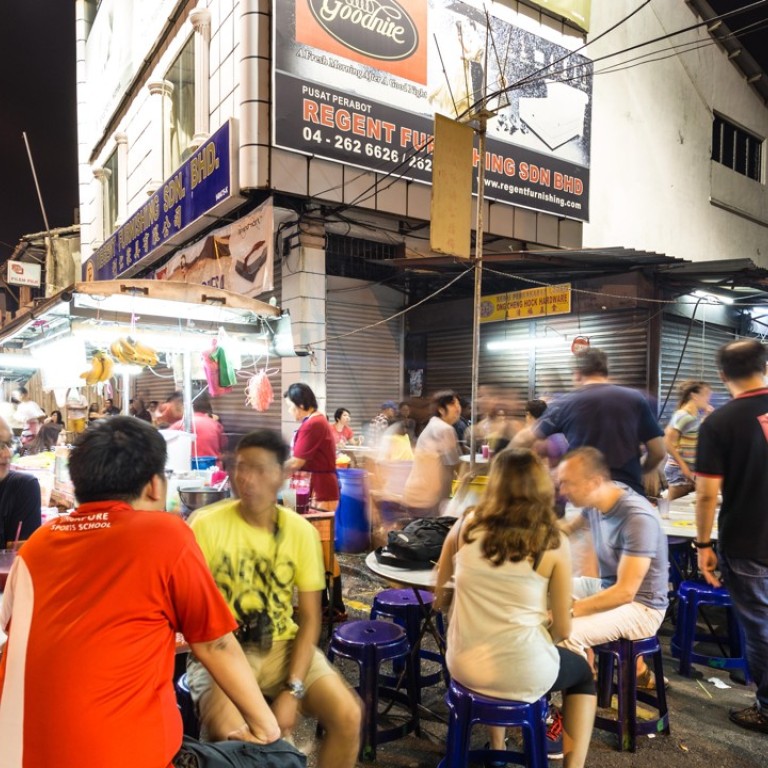
The best things to eat in Penang, Malaysia’s food paradise, from laksa to nasi campur
In the second of Susan Jung’s two reports on finding the most delicious food in Penang, she tries an asam laksa that stuns her with its complex flavours and coconut rice so good she brought takeaway back to Hong Kong
“Actually, I prefer the food in Ipoh.”
This statement was so shocking that my friend, Peter Yeoh, and I stopped eating our breakfast of lor bak.
Eat your way around Ipoh, newest Malaysia foodie destination
The food had been prepared by a septuagenarian vendor and his wife at Kheng Pin Cafe, a small hawker centre at the junction of Jalan Penang (Penang Road) and Jalan Sri Bahari in George Town. In addition to the lor bak – deep-fried five-spice pork sausage wrapped in bean curd skin – we were also eating other fried foods, including prawn fritters and tofu, from a selection that ranged from 1.2 ringgit to 3 ringgit (30 US cents to 73 US cents).
Served with sliced cucumber, a sweet, mild chilli sauce and a thickened sauce that has as its base a braising liquid from cooking the lor bak’s pork sausage, it all made for a hearty, inexpensive breakfast that we enjoyed with cups of thick Malaysian coffee with condensed milk.
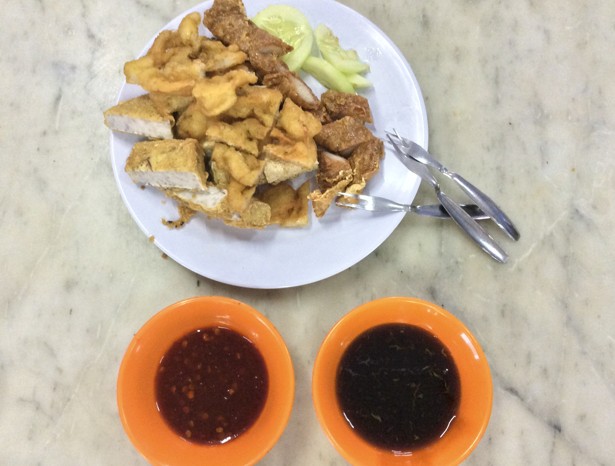
The sacrilegious statement was uttered by my Hong Kong friend’s mother, whom I call Auntie. She, along with her driver, Ah Soon, was taking me and Peter, a food-loving local Penangite who reviews for the Hungry Onion website, to some of her favourite eating destinations in Penang, where her family has lived for at least four generations.
“Penang food tends to be more oily and spicier; [Ipoh food] is more Cantonese or Hakka in style,” was Auntie’s explanation for her preference.

I don’t know if I would call Penang food oily, but it certainly is richer – and often spicier – than Cantonese and Hakka food. It does depend, though, on whether you’re eating from a Chinese, Malay or Indian vendor, or one of the many fusion dishes that evolved within the different ethnic groups.
This was the second day of my trip from Hong Kong to eat as much Penang food as possible in two-and-a-half days. So immediately after downing forks on our breakfast, Ah Soon drove us to George Town’s Chowrasta Market for a few light snacks of white curry mee (like the one I had the day before it was strangely mild), koay teow th’ng (rice noodles with fish balls, duck meat and garlic oil) and chee cheong fun (rice flour noodle rolls with hoisin sauce, chilli sauce and fermented shrimp sauces).
I had been anticipating our lunch ever since starting to plan for the trip: nasi campur at Nasi Melayu Mahadi in the Tanjung Tokong suburb of George Town.
Chinese regional cuisine: Sichuan, and how chefs in Hong Kong adapt it for local tastes
This covered open-air food stall specialises in the Malay dish of nasi campur, which consists of rice (nasi) with a buffet selection of toppings, mostly ranging from 1 ringgit to 6.50 ringgit. The offerings were extensive, including raw and cooked vegetables, fried fish, curry fish and seafood, fried chicken, egg dishes, and stuffed bean curd.
I asked for a small half-and-half serving of white rice and tomato rice, then tried hard to limit my selection to what I could finish. In the end, I had small portions of soft chicken livers, sliced beef lung in a dark thick sweet/tart sauce, a delectable pineapple curry, and a crunchy, refreshing pickle of string beans and shredded carrot.
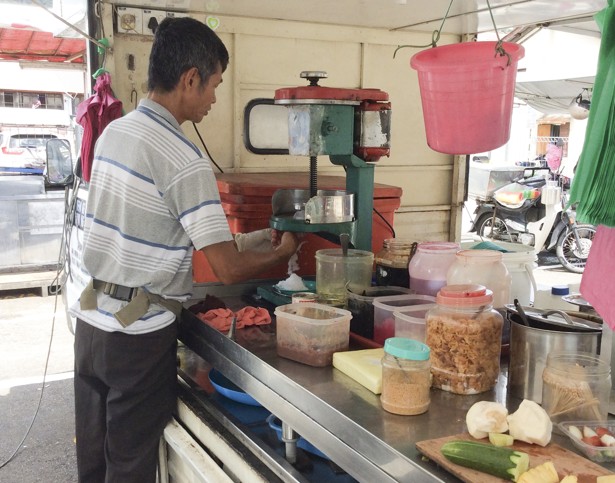
An hour-long drive from George Town to Penang island’s southwest town of Balik Pulau gave us a little time to digest our heavy lunch before having more food at Kim Seng Kopitiam (a kopitiam is a coffee shop that sells drinks and food).
The menu lists asam (sour) laksa and Siam laksa (asam laksa with coconut milk) for 5 ringgit for a small bowl and 6 ringgit for a large bowl; you can also order half and half. The Siam laksa was good, but the asam laksa was something else: my mouth was almost overwhelmed by the deliciously complex sour and sweet fishy flavours, with the pungency of the shrimp sauce and the spicy heat balanced by cooling pineapple, cucumber and lettuce.
Since we had driven so far, Auntie took the opportunity to fill her metal thermoses with the asam broth and noodles, packaged separately so the noodles wouldn’t get soggy – takeaway food for her husband and a friend.
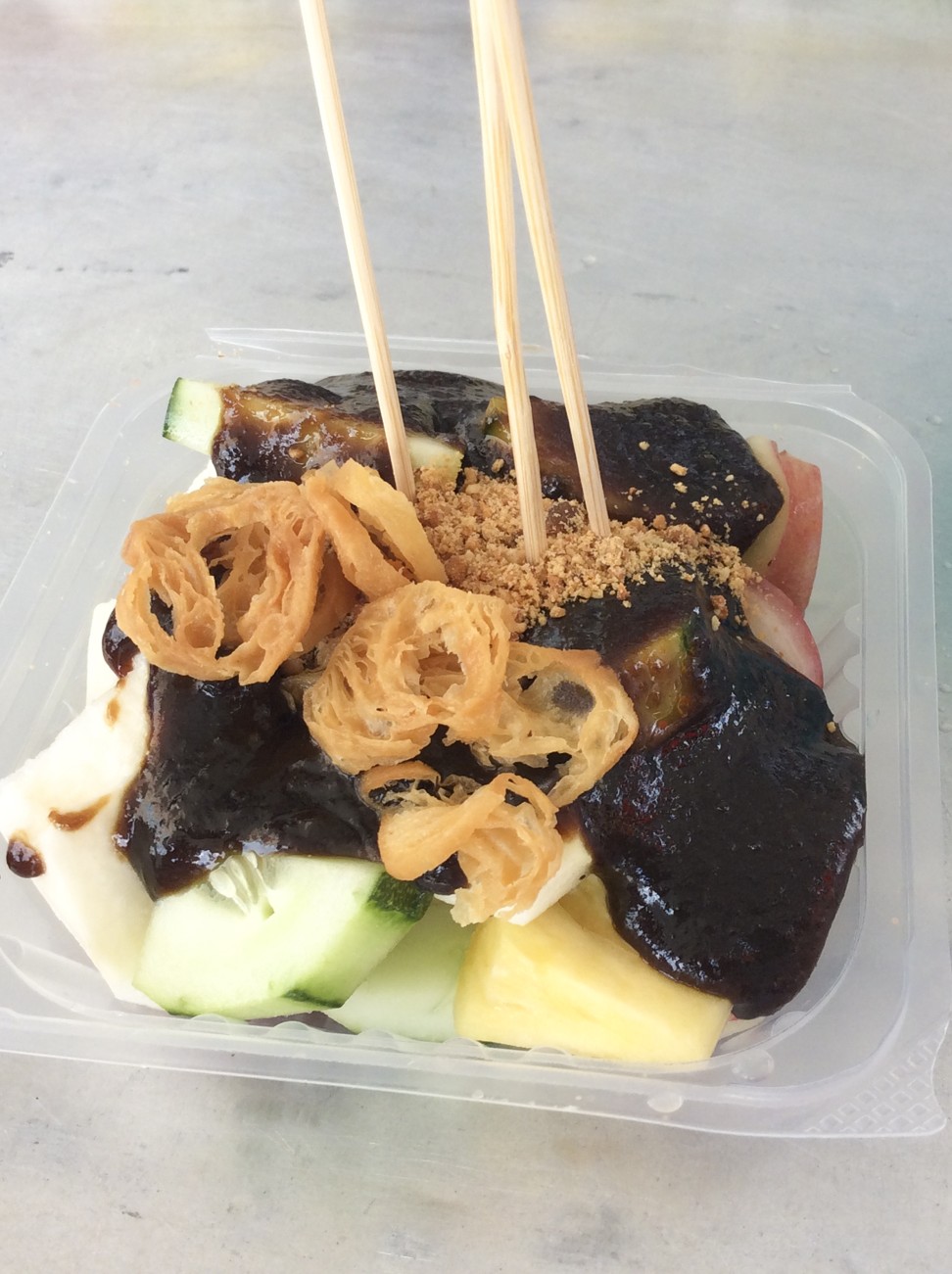
Our plans for mee udang – Malay prawn noodles – were foiled when, on the drive back to George Town, we found one stall closed for the day and another without electricity. We sated our very faint hunger pangs with rojak (raw vegetables and fruit with a rich fermented shrimp paste sauce), ais kacang (an iced bean dessert) and cendol (iced sweet dessert with green rice flour jelly, coconut milk and palm sugar syrup) from a roadside stall.
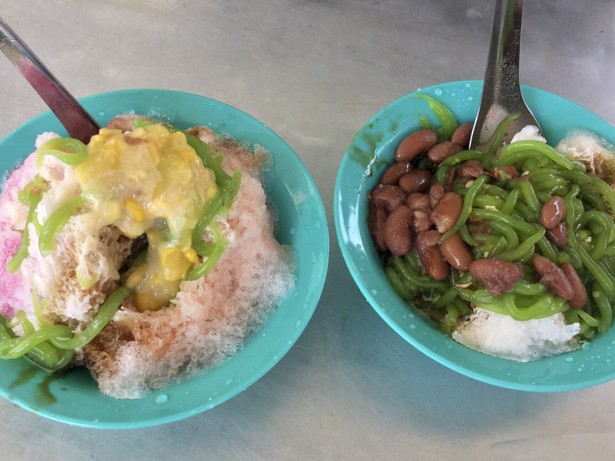
Unsurprisingly, we weren’t really hungry for dinner at Winn’s Cafe, which specialises in Nyonya dishes – a unique cuisine that evolved generations ago from the intermarrying of Chinese immigrants with ethnic Malays. But our appetites were revived when the simply presented food was placed on the table.
The appetiser set included a combination of vivid tastes and textures: otak otak (fish custard), pie tie (crisp shells filled with cooked vegetables) and chicken lor bak. But even better was a wonderfully fragrant nasi ulam (a tepid dish of rice with a chiffonade of fresh herbs that includes wild betel leaves), a rich perut ikan (fish stomach with fresh herbs and spices), and a refreshing salad of finely sliced winged beans with ginger flower and shallots.
How to get to know India through its food: an insider’s guide
For me, however, the star dish was jiu hu char which, brown and soft, did not look at all enticing. The others sniffed at it, saying that their cooks would have julienned the yam bean (jicama), cuttlefish and shiitake mushrooms far finer. But I ate until the bowl was empty, wrapping the ingredients in a lettuce leaf and adding a dab of spicy sambal and a squeeze of calamansi.
My final meal in Penang was an early lunch the next day, but it was so good that I also had it for a snack at the airport and dinner back home in Hong Kong.
Ali Nasi Lemak Daun Pisang is the first food stall you’ll see at Sri Weld Food Court on Beach Street in George Town. Their coconut rice (nasi lemak) with boiled egg, wrapped neatly in a pyramid of banana leaf, comes with the diner’s choice of sambal ikan bilis (tiny fish in chilli paste), fried fish, shrimp or cuttlefish, and costs 1.80 ringgit.
Chinese regional cuisine from Guizhou: where to eat it in Hong Kong
The first bite was so spicy I started to cough, but it was so delicious I kept eating, wanting more. The egg and chilli-free rice at the bottom of the pile provided respite to the spice. After finishing my portion, I went back to the stall and ordered two more for takeaway, tucking them into my carry-on luggage so they wouldn’t get squashed.
I came back to Hong Kong two kilos heavier than when I left.

